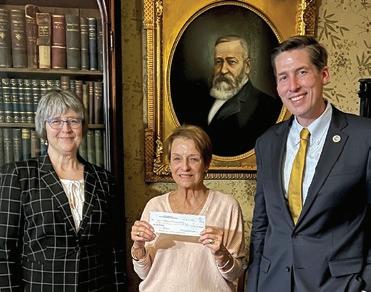
9 minute read
Benjamin Harrison and the INTERAMERICAN CONFERENCE OF 1889–1890
Few have noticed that in the realm of foreign policy and international relations, Benjamin Harrison made history as President of the United States. He articulated a vision of the world and America’s role in the world that served as a model for American policymakers in the 20th and 21st centuries. Until now, in the exhibit “Pan American,” that achievement has been under-appreciated.
The assumption of most historians, scholars, and commentators is that the primary driving force of foreign policy in the Harrison Administration was Secretary of State James G. Blaine. The standard interpretation is that Harrison chose the more charismatic and expressive Blaine as Secretary of State in order to prevent him from seeking the presidency on his own. As a result, Harrison chose Blaine and then stepped to the side as the Maine Republican crafted foreign policy in the late 1880s and early 1890s.
Advertisement
The actual record shows that Harrison was an insightful president, a shrewd politician, and above all, a visionary leader.
Harrison consulted with one of his closest advisors, Murat Halstead, before making Blaine Secretary of State in early 1889. Halstead observed that Lincoln had also chosen a personal and political rival of his own—William Seward—to be Secretary of State. Halstead added a crucial point: Lincoln sent Seward a frank, candid private letter outlining his expectations for Seward’s conduct at the State Department. Harrison liked the technique.
Harrison embraced Lincoln’s approach and then went one important step further. Before sending the completed private letter to Blaine, Harrison poured over a draft original copy. He wrote and reflected, edited and analyzed, re-wrote and finalized, an exhaustive process that produced the precisely-worded letter that he ultimately dispatched to Blaine. Harrison amplified Lincoln’s approach, implementing a “Lincoln-Plus” model of leadership. It’s a lesson that can serve leaders today who are faced with selecting vital members of their teams.
But there is more to be learned from Harrison’s letter to Blaine. The letter suggests a different dimension of Harrison’s leadership and his historic work as president in foreign policy.
WRITTEN BY DANIEL T. MILLER, PHD, HISTORICAL SOLUTIONS LLC
Harrison’s strenuous approach to the Blaine letter showed that he had a unique vision for America’s role in the world. Harrison was emphatic in asserting that Blaine had to focus on relations with Central America and South America. Harrison believed that the United States had a special
Harrison identified a theme of American western hemispheric relations that predated him in the Monroe Doctrine of the 1820s as well as his predecessor, Grover Cleveland. Cleveland had acted to organize an “Inter-American” meeting before he left the White House. Harrison seized upon the event and made this “Inter-American Conference” his first step to improved American relations in Central and South America. Harrison also knew Blaine agreed with the western hemispheric policy, but interestingly, he nevertheless repeated the importance of it in his private letter to his new Secretary of State. Harrison was taking no chances of any misunderstanding on the point.
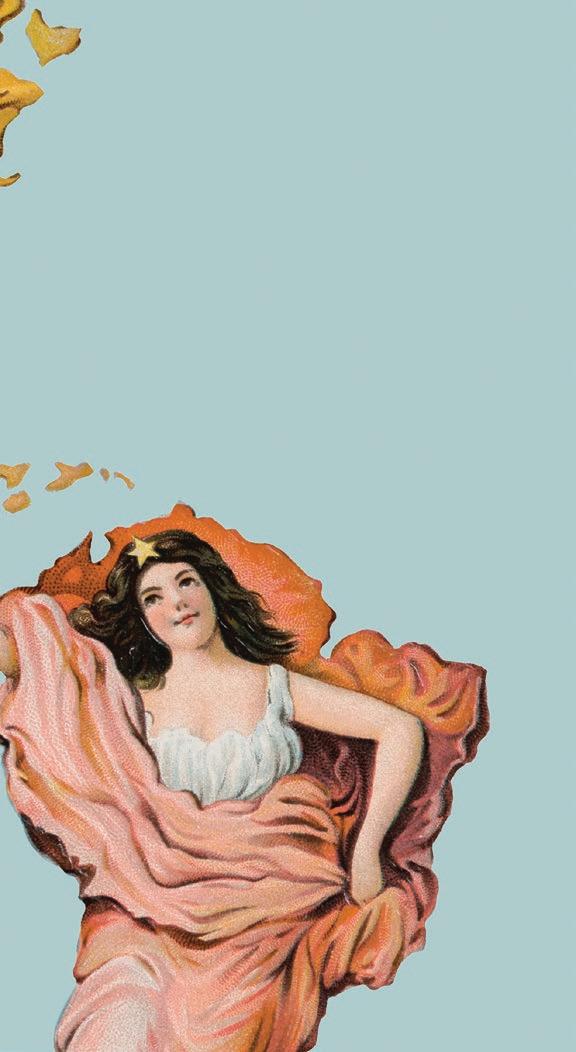
Harrison led the effort to form the American delegation to the Inter-American Conference. He included men who were leaders in the private sector and the public sector, from all regions of the nation, and from both the Democratic and Republican parties. The group, including Andrew Carnegie in his first major international service, was a set of intelligent, serious, and duty-minded men. The group was a driving force at the Conference.
Months later, during his unprecedented tour of the American nation, Harrison returned again and again to Central and South America as the basis of American foreign policy. In his numerous speeches in cities and towns across the United States, Harrison spoke eloquently on the need for peaceful American conduct predicated on shared economic prosperity, mutual respect, and widespread individual freedom. He looked to new naval developments as critical to maintaining order and security necessary for that vision. And he rooted American global success in a healthy, vibrant, and engaged American republic at home. Harrison embodied a bold and vigorous view of American foreign policy and international relations.
Benjamin Harrison peered into the century ahead and saw his vision of an American future.
1888 In the first recording of an American president, this was the voice of Benjamin Harrison. His speech begins,
[Listen to the recording]
Did You
Know?
FROM PAN-AMERICAN TO PAN AM GAMES:
Almost exactly one century after President Benjamin Harrison inaugurated the Pan-American Conference, his hometown of Indianapolis, Indiana would host the 1987 Pan-American Games. In many ways, it was a comingof-age experience for the city, demonstrating the success of the amateur sports strategy it had employed, and helping bring Indianapolis to greater prominence on a national and international stage. Over 4,300 athletes competed, representing 38 countries, and bringing around $175 million to Indianapolis’s economy.
SEE FOR YOURSELF! Special Exhibit “Pan American: Forging Bonds of Prosperity and Peace” opens on May 18, 2023 and is included in general admission.
Admission to the Union is provided by the Admissions Clause of the United States Constitution, which went into effect on June 21, 1788 in the nine states that had ratified it, and the U.S. federal government began operations under it on March 4, 1789, when it was in effect in 11 out of the 13 states. Since then, 37 states have been admitted into the Union.
ORIGINAL 13 STATES: Delaware, Pennsylvania, New Jersey, Georgia, Connecticut, Massachusetts, Maryland, South Carolina, New Hampshire, Virginia, New York, North Carolina, and Rhode Island
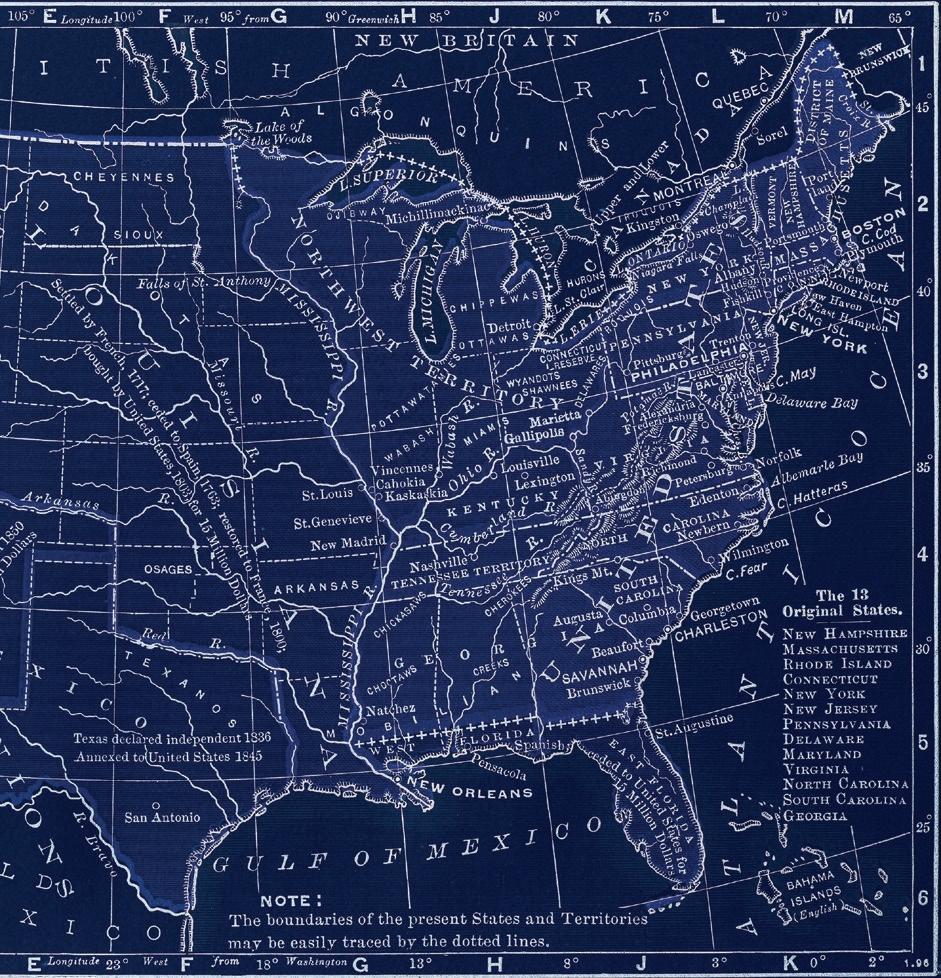
George Washington (1789-1797) admitted: Vermont, Kentucky, and Tennessee
Thomas Jefferson (1801-1809) admitted: Ohio
James Madison (1809-1817) admitted: Louisiana and Indiana
James Monroe (1817-1825) admitted: Mississippi, Illinois, Alabama, Maine, and Missouri
Andrew Jackson (1829-1837) admitted: Arkansas and Michigan
John Tyler (1841-1845) admitted: Florida
James K. Polk (1845-1849) admitted: Texas, Iowa, and Wisconsin
Millard Fillmore (1850-1853) admitted: California
James Buchanan (1857-1861) admitted: Minnesota, Oregon, and Kansas
Abraham Lincoln (1861-1865) admitted: West Virginia and Nevada
Andrew Johnson (1865-1869) admitted: Nebraska
Ulysses S. Grant (1869-1877) admitted: Colorado
Benjamin Harrison (1889-1893) admitted: North Dakota, South Dakota, Montana, Washington, Idaho, and Wyoming
Grover Cleveland (1893-1897) admitted: Utah
Theodore Roosevelt (1901-1909) admitted: Oklahoma
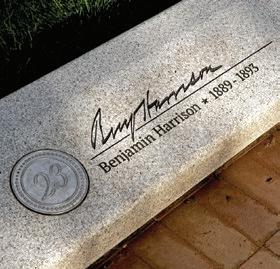
William Howard Taft (1909-1913) admitted: New Mexico and Arizona
Dwight D. Eisenhower (1953-1961) admitted: Alaska and Hawaii
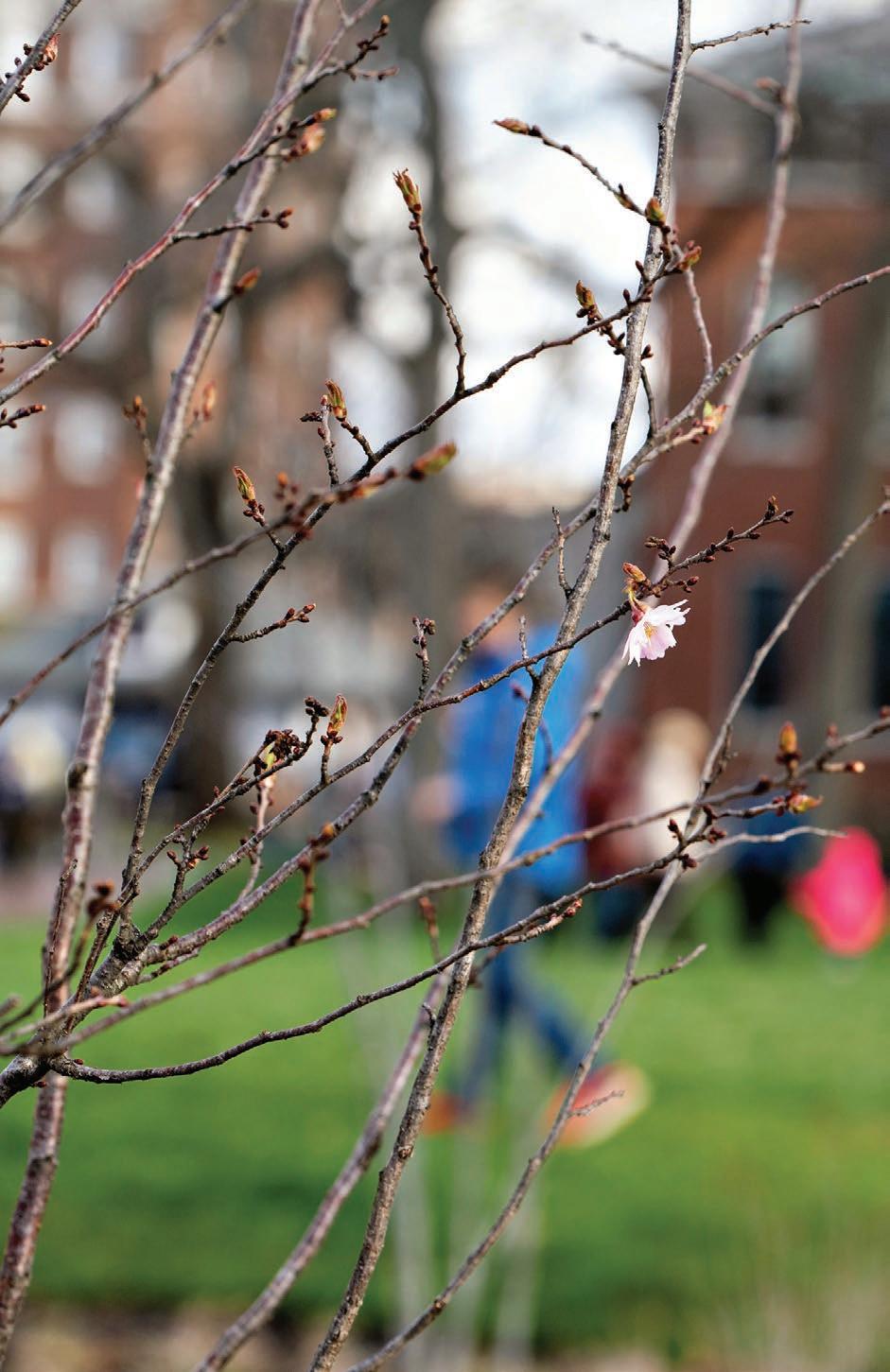
The first blossom on the “Autumnalis” cherry tree in Sarah Evans Barker Citizenship Plaza bloomed during the 8th annual Presidential Egg Roll on April 1, 2023. Over 200 children and adults braved a bright but blustery day and enjoyed a fun morning on the south lawn.
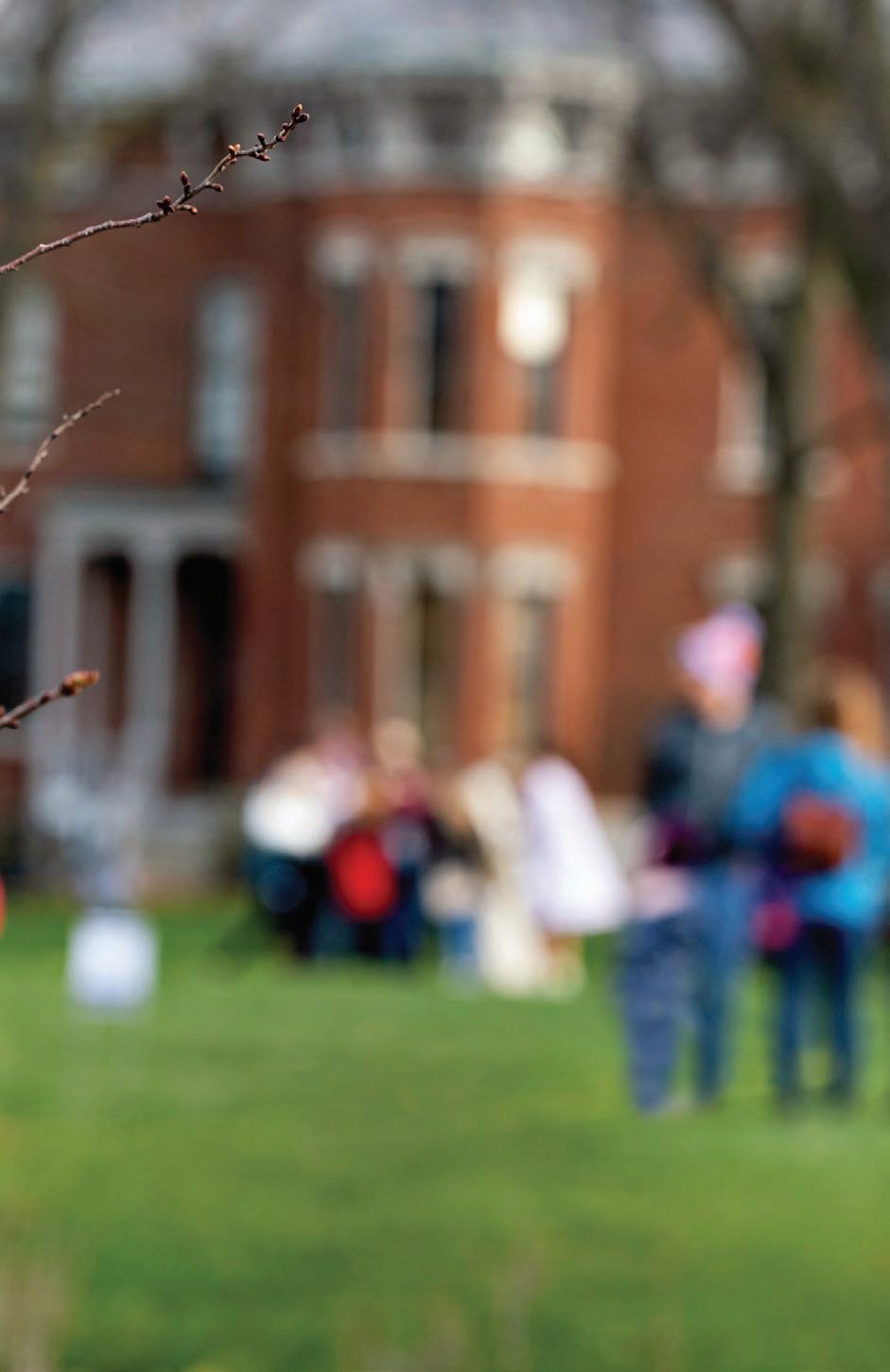
Want to learn more about educational programs for the students in your life? Go to bhpsite.org/ learn/education/ to find out more today!
In this regular feature, we highlight some of the people, schools, and partners that make our educational outreach to thousands of students each year possible.
Hello! My name is Sarah Stark. I am a fourth grade teacher at Saint Maria Goretti in Westfield, IN. I live in Noblesville, IN with my husband and 3-year-old son. I have been in education for 19 years, and have spent the majority of my teaching career in fourth grade. In my opinion, fourth grade is one of the most exciting years to teach Social Studies. To be able to travel to places that we learn about in our lessons is so valuable.
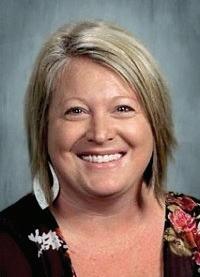
Many organizations around Indiana provide amazing resources for fourth grade students and teachers. The Benjamin Harrison Presidential Site is one of these organizations. This year was my 12th (missed a year due to the pandemic) visit to the Presidential Site. I would highly recommend this trip to any Hoosier (old or young!). My students and I look forward to this visit each year. His house is well taken care of; the students really enjoy seeing what things looked like or would have looked like in Benjamin’s home. Going on the tour of the house offers many lessons on what life was like in the early days for Hoosiers. Our tour guides have always been well educated on the Harrison family and this time in history. My students have always felt comfortable asking questions throughout our visit. Even with visiting so many times, I find myself learning a new fact or two each time.
Besides touring the house to learn about the Harrison family, my students attend the Settlers and Surveyors program. This program uses a hands-on approach to teach the students what life was like for settlers as they moved to the open area of Indiana, how to set up a town, and why they chose to do things the way they did. We especially enjoy working with Mr. Roger Hardig. He is full of knowledge of our state and country and adds some humor to his lessons as well. The students and parent chaperones enjoy listening to him. My class discusses what we have learned during this program through our year in Social Studies.
We are so thankful for this opportunity to visit the Presidential Site each year!
Benjamin Harrison personally kept track of the of the house’s construction during 1874 and 1875 in this book. This “Perpetual Diary” contains records of architects, consultants, and building contractors. It is an invaluable source of information about not only the building of the house, but also of the companies conducting business in Indianapolis at the time.

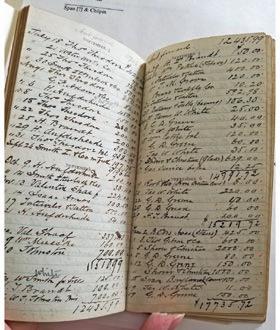
The first page from the very first visitor register. It is dated June 25, 1938, the 50th anniversary of Benjamin Harrison’s presidential nomination and the opening date of the Memorial. Do you see any names that you recognize? The first signature is Matthias L. Haines (1850-1941), Pastor Emeritus from the First Presbyterian Church a post he held for over 50 years. On the back (page2) are signature of Harrison family members: dated October 15, 1938 – Mary Lord Harrison (Mrs. Benjamin Harrison), Elizabeth Harrison Walker (daughter), and – no date J. R. McKee (son-in-law).
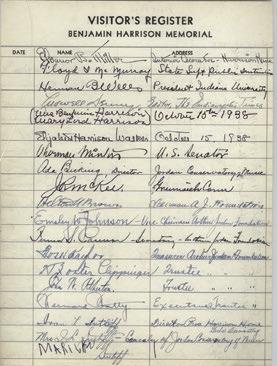

Other names of note: James E. Watson, former House of Representatives and Senator from Indiana, Lewis Ludlow “Member of Congress,” and Herman B. Wells, President of Indiana University.
Tour Tickets
Early tour tickets made similar to Victorian calling cards state that “Visiting Hours” are 10am to 4pm. On the back written in pencil is a note stating “Open at 12:00 Today.”
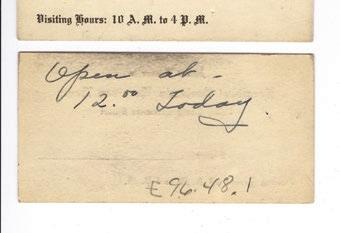
In the last month, the Benjamin Harrison Presidential Site was deeply saddened by the loss of two exceptional veteran volunteers, Jim Johnson and Martha Buehner. We treasure every volunteer who chooses to give their time and talents to our organization, but the impact Jim and Martha left on the museum will be felt for years to come.
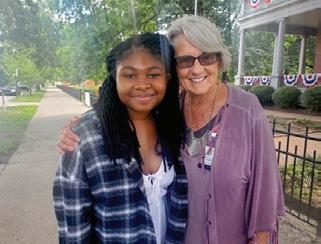
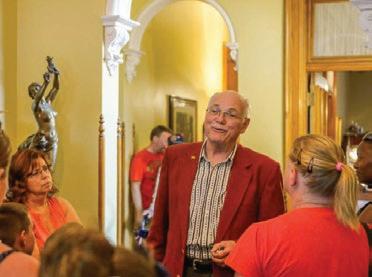
From portraying our beloved butler “Charles” on live reenactment days, inspiring students with his tours around the museum, and giving his vocal talents to provide voice-overs for promotional materials, there wasn’t an area of the Presidential Site that Jim didn’t have a stake in. In addition to leading tours at the Presidential Site, he volunteered as a tour guide with the Indiana State Capitol to educate the public about his beloved state. After his passing, Jim was honored as a Sagamore of the Wabash recipient for his service to the state of Indiana. Jim was a great man who will be missed dearly by his natural family and his family at the Presidential Site.
Martha was an education superstar. After over 40 years teaching first graders, she brought her unique skills to the Presidential Site and inspired countless adults and students during her many years of service here. Martha served as a weekly docent and worked with our Future Presidents of America program every year. The first Future Presidents of America program began in 2015, and Martha had been there for every single one. She worked primarily as a mentor for the students and loved each of them dearly.
A unique educational program offered at the Presidential Site was named after Martha’s unique way of teaching her first-grade students about the Pledge of Allegiance. Martha explained the pledge as a promise you make to be a good student, a good citizen, and to help in your community. The program was named A Pledge is a Promise and teaches students about adopting the Pledge of Allegiance and the civic responsibility of American citizens.
Among the many improvements made through the recent capital campaign, further restoration of the Harrison’s residence across three floors of the residence has been a priority. This builds upon the work of many years, most recently in 2008–2009 as the front parlor, back parlor, and library were meticulously restored, and corresponding window treatments added, with period lace curtains funded through a generous grant made by THE QUESTERS.
THE QUESTERS is an entirely volunteer organization dedicated to the study, conservation and preservation for today’s historical objects. With their local chapter in Lockerbie Square, we are pleased to share that they recently awarded the Presidential Site a grant in order to restore the remaining window treatments to 1880s period appropriate lace.
During the Harrison period, most of the house’s windows appear to have been provided with roller shades hung between the sash and the inside blinds and most appear to have been screened with lace sheer curtains beyond the interior face of the blinds. In 2022 and 2023, rooms and halls have been restored with historic paint colors discovered in the recent paint analysis along with reproduction wallpapers hand drawn to match what is seen in original 1888 photographs. However, the front stairway window and many of the rooms still had lace from the 1970’s restoration. THE QUESTERS gift will complement and complete this important transformation of the first floor and entry hall leading up to the front stairway window once installed later this summer. We thank them for their generous support!
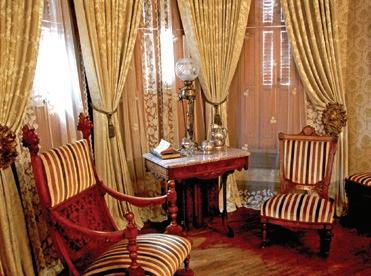
We would also like to thank Presidential Site volunteers Sherri Nagel-Smith and James Douglas Smith for their gift in support of the purchasing historic lace.
